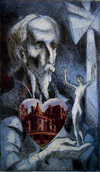 At The Heart of Romance
At The Heart of Romance
by Roy H. Williams
From Claude Monet’s impressionistic portrait of his wife and son, to Sue Monk Kidd’s tender book, The Secret Life of Bees, to the nosecones of bombers and the biceps of bikers, to the garish and awkward Miss America pageant, we continue to project the feminine ideal onto whatever canvas we can find to hold it.
But Don Quixote’s perfect woman lived only in his mind: "Her name is Dulcinea, her kingdom, Toboso, which is in La Mancha, her condition must be that of princess, at the very least, for she is my queen and lady, and her beauty is supernatural, for in it one finds the reality of all the impossible." – from Don Quixote by Miguel de Cervantes, 1605.
I believe it is our search for Dulcinea, the softer side of God, that is the driving force behind much of our music, literature, sculpture, architecture, photography and painting.
In 1607, a 15 year-old prince of India caught a glimpse of a young girl hawking silk and glass beads in the Meena Bazaar. Five years later when she was 19, he married her and made her his empress. But it was to be a marriage cut short. When his beautiful Arjumand Banu died after just 19 years of marriage, Shah Jahan built a memorial to her that is recognized as one of the world’s supreme accomplishments of architecture; the Taj Mahal.
George C. Boldt came to America in the 1860’s, the son of impoverished Prussian parents. Encouraged by his wife Louise, Boldt became America’s most successful hotel magnate. His empire included New York’s Waldorf-Astoria and Philadelphia’s Bellevue-Stratford. At the pinnacle of his success, Boldt purchased an island and began building a 120-room stone castle to be his gift to his wife on Valentine’s Day. But in January, 1904, Louise Boldt died. Heartbroken, her unstoppable husband telegrammed the construction crews that all work be stopped. Three hundred workmen dropped their tools and walked away. Boldt never returned to the island.
Throughout his life, surrealist Salvador Dali was energized by his wife, Gala, the subject of many of his greatest works. When Gala passed away in 1982, Dali stopped painting. Seven years later he died.
What did Salvador Dali see when he looked at Gala? What strength did George Boldt draw from Louise? What magic danced in the eyes of Arjumand Banu?
I believe it was Dulcinea.
Roy H. Williams
PS – Wedding Chapel Dulcinea will be the heart of Wizard Academy, offering a postcard-perfect venue for couples to exchange their vows at no charge; a gift to the world’s lovers from the students and friends of Wizard Academy. So far, we’ve collected about two-thirds of the funds necessary to complete the chapel by its April 23rd dedication date and we have confidence that the rest of the money will soon arrive. We hope you’re planning to share that day with us.
Today’s illustration shows a glimpse of Boldt Castle within a heart overlaid onto an image of the extraordinary painting of Don Quixote and Dulcinea, by Martin Mondrus.

Beautiful post. It’s a shame that man’s creation of the ultimate masculine, that punishing, disappointed father has created so much unhappiness.
Even more of a shame, how men look to women for that source of compassion, which became self-denial in men.